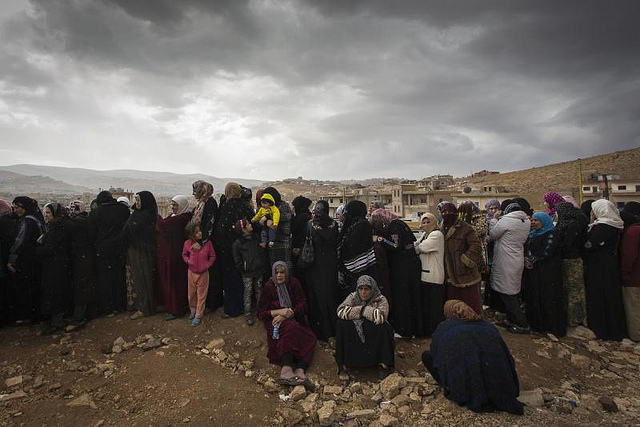A recently released Department of Foreign Affairs and Trade evaluation details some successes but also highlights shortcomings in Australia’s humanitarian response to the Syrian crisis. While Australia was an early-responder to events in Syria, overall Australia’s response has been characterised by a lack of effective planning and unpredictability in the availability of aid funding. As the conflict enters its fifth year, Australia has provided 14 separate partners with relatively small amounts of funding across 54 allocations at varying times. This means Australia’s aid partners haven’t had any certainty on when, what and how much they expect to receive from Australia in funding, compromising their impact in the field.
Additionally, the amount Australia has provided in humanitarian aid to Syria from mid-2014 to mid-2015 has dropped from $53.7 million to less than $8.8 million and there has been no documented strategy on how or why certain programs were funded. As humanitarian requirements in Syria grow and change due to the complex and ongoing nature of the crisis, DFAT’s lack of a documented strategy regarding the $130 million already spent not only affects the ability of our humanitarian partners to deliver effective programs, but also raises questions regarding the value for money the DFAT aid delivers.
Aid as a counter-terrorism measure.
A concern for Australia, as well as many other donor countries, has been the threat posed by foreign fighters returning from the Syrian conflict or homegrown terror attacks inspired by the likes of ISIS. Given that many Western countries are now directly involved in military action against ISIS, an increasing number of foreign fighters may view their circumstances through the prism of a global war. This places countries in the military coalition—such as Australia—at greater risk of blowback.
Counter-terrorism research increasingly shows that punitive measures alone are ineffective in tackling terrorism and that they must be combined with non-coercive programs. A recently published policy paper by the Brookings Institute suggests that rather than over-relying on punitive measures to combat terrorism, increasing funding and involvement in humanitarian programs that aim to help people affected by the conflict in Syria has the potential to de-radicalise a significant portion of foreign fighters who were originally motivated not by violence, but by a genuine desire to defend the Syrian people against the brutality of the Assad regime. Older research by AidData also suggests that foreign aid has the ability to decrease incidents of terrorism especially when the funding is targeted towards sectors such as education, health, civil society and conflict prevention.
Recent changes to federal counter-terrorism legislation are insufficient in themselves to deter Australians from fighting in Syria or preventing attacks at home. A more nuanced approach that couples appropriate domestic legislation with a clear humanitarian strategy for Syria, which focuses both on immediate humanitarian requirements as well as medium to longer-term community resilience and development is necessary for counter-terrorism measures to be more effective. Resilience and development projects could include civil society development and increasing the rule of law within liberated Syrian communities, providing children with access to education as a normalising measure and an increased focus on livelihoods and creating economic opportunities in refugee populations.
Value for money of Australia’s humanitarian spend on Syria.
In 2015, the UN has requested a staggering US$8.4 billion to help 18 million people within Syria and the immediate region. This is the largest humanitarian appeal in UN history. While the primary objective of humanitarian spending remains to help people in need and alleviate suffering, both donor countries and the taxpayers that contribute to government coffers have a right to expect oversight and value for money from the programs they fund.
The recent Federal budget announced a further $1 billion in aid cuts in 2015/16. The budget also confirms an additional $2.7 billion of cuts in 2016/17 and 2017/18. Funding to the Middle East and North Africa region, including Syria, has been one of the hardest hit, again halving from $8.8 million in 2014/2015 to a projected $4.2 million in 2015/2016. By 2016/17, Australia’s total international humanitarian assistance as a share of Gross National Income will fall to 0.22% – the lowest in recorded history.
The shortage of allocated funds is a concern considering the scale and impact of the crisis. However, if the trend continues, value for money would be better achieved if Australia developed a clear strategic plan for its humanitarian spending that addressed short, medium and long term concerns in tandem. Such a plan needs to remain agile, but could include consolidating the number of humanitarian partners DFAT uses in the region focussing on fewer partners who have a long-standing presence and well-established capacity in the region. This would reduce transaction costs and optimise the money being spent. Additionally, specific levels of funding could be provided at regular intervals to partners to help augment more reliable and dependable program delivery while still allowing DFAT the capacity to contribute emergency top-ups if an incident, such as a winter storm or an increase in violence in a certain area, occurs.
Developing a clear humanitarian strategy for Syria.
Considering the widening gap between Australia’s funding commitment and the obvious need, there’s an increasing imperative for DFAT to develop a clear and more targeted strategy for Syria. This is not only a humanitarian imperative given the extent of the crisis, but will also better serve Australia’s own domestic counter-terrorism policy interests and offer greater value for money for the Australian taxpayer.


